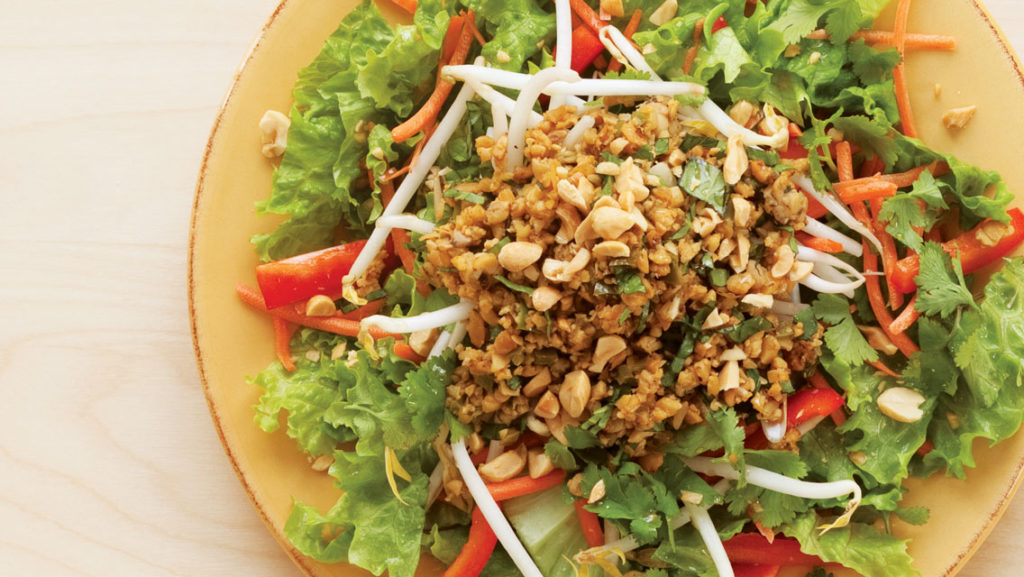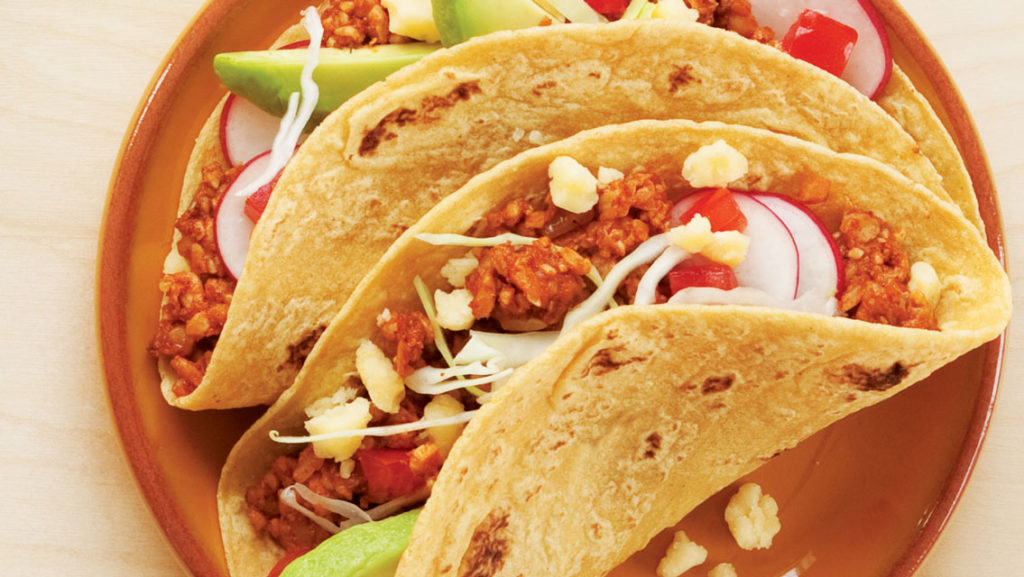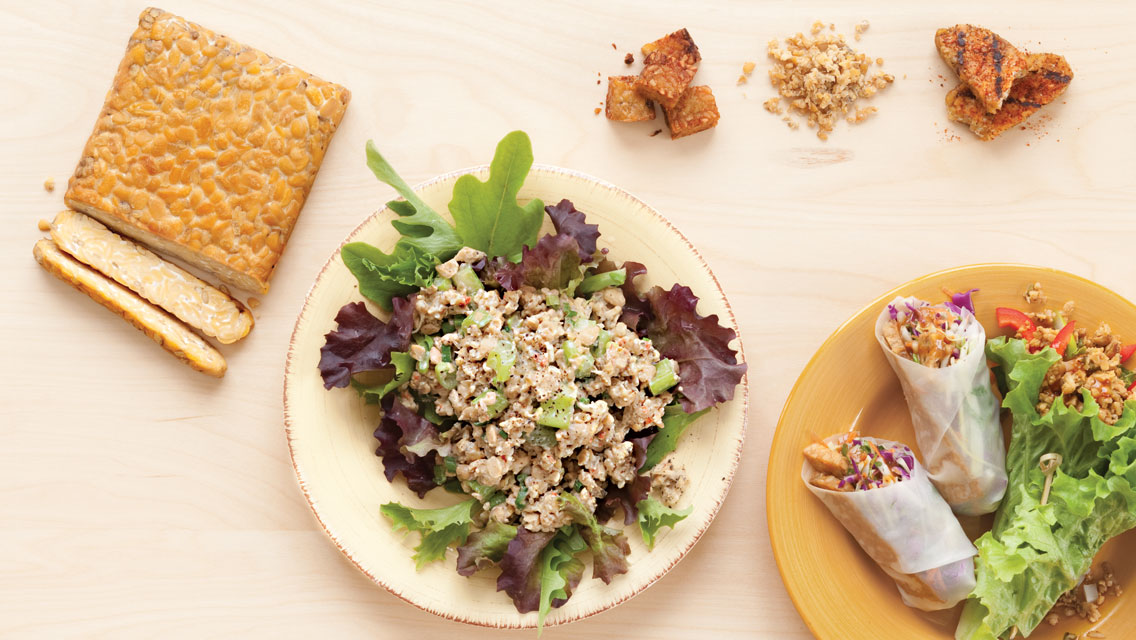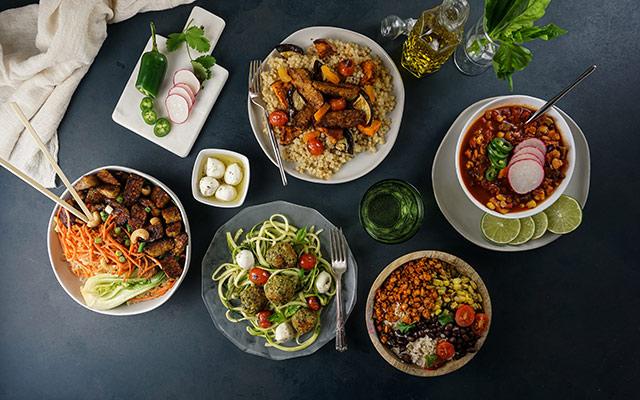Tempeh is often confused with tofu. But, in fact, these two soy products are quite different: Tofu is a curd made from unfermented, mashed soybeans. Tempeh is a fermented soybean cake that’s less mechanically processed, more dense in nutrients, less likely to create digestive distress, and, thus, far better for you (see “The Benefits of Fermented Soy” in the Web Extra section below).
A terrific source of protein, tempeh (which originated in Indonesia) is made from whole soybeans that have been layered and, like miso and soy sauce, fermented. When cooked — and tempeh should always be eaten cooked — it has a nutty, smoky and mushroom-like flavor.
Because of its firm, chewy texture, tempeh can be handled much like meat and used as a meat substitute. It’s affordable, easy to prepare and can be incorporated into a wide range of dishes.
Best when marinated, tempeh mixes with various ingredients to create great flavor combinations, including Asian (soy, ginger, garlic, sesame), Mexican (cumin, chili powder, cilantro, tomato), Italian (basil, oregano, balsamic vinegar, olive oil) and Thai (basil, coconut milk, fish sauce, ginger).
While traditional tempeh is made with soybeans alone, you can also purchase it with other grains included, like barley, millet and brown rice. Some stores also carry a thinly sliced smoked tempeh that can be used as a vegan version of bacon.
If you haven’t already made tempeh a part of your healthy-cooking repertoire, it’s high time you did! Here are some ideas to get you started.
Nutrition Know-How
- A 4-ounce serving of cooked tempeh provides 41 percent of the daily recommended amount of protein.
- Tempeh is a good source of probiotics, gut-friendly microbes that help control harmful bacteria in the body.
- Rhizopus oligosporus, a fungus used to ferment tempeh, produces a natural antibiotic that is effective against certain harmful bacteria.
- Tempeh is high in riboflavin, which helps the body produce and regenerate glutathione. This key antioxidant, which can be depleted by stress, poor diet, pollution, toxins, medication and a host of other stressors, is essential to your immune system and detoxification process and helps prevent chronic illness.
- The fermented soy in tempeh is high in vitamin K2, which can help prevent osteoporosis, cardiovascular disease, certain cancers and diseases of the brain — including dementia.
- Tempeh’s isoflavones have been shown to reduce symptoms of menopause in women and to reduce the risk of prostate cancer in men.
- The protein and fiber in tempeh can help regulate blood-sugar levels. Tempeh’s fiber also helps remove carcinogenic toxins from the body and may be able to lower rates of colon and breast cancer.
- Tempeh is rich in minerals, including calcium, magnesium, iron, zinc, manganese, copper, phosphorous and potassium.
Creative Tempeh Tricks
For a vegetarian “chicken salad,” crumble tempeh and simmer in water with a pinch of dried sage and thyme, and some garlic and Dijon mustard. Drain and mix with your favorite chicken salad ingredients. Serve on bread or on a bed of greens.
For spring rolls, wrap strips of cooked tempeh and vegetables in rice paper and dip in your favorite sauce. Or try Thai Basil Tempeh crumble in lettuce wraps (featured below) with chopped water chestnuts, green onions and red peppers.
Pan Fried
Put some protein in your favorite salad with tempeh croutons. Cut tempeh into cubes and marinate in your favorite dressing, vinaigrette, or sauce. Fry in a small amount of oil on all sides until brown and crispy.
Grated
Try grated or crumbled tempeh in pasta sauce, soup, tacos and chili. A great way to introduce tempeh to your friends or family is to substitute half the beef or turkey in a recipe with crumbled tempeh.
Grilled
Grilled or pan-seared tempeh is terrific on top of your favorite salad or in a whole-grain wrap. Slice tempeh, brush with oil and sprinkle with your preferred spices (a Cajun mix is always good). Grill on both sides. Lightly brush with a barbecue or simmer sauce and heat on both sides again.
Kitchen Tricks
- Before marinating tempeh, cut it to preferred size and steam or simmer in water for 10 minutes on the stove. This removes bitterness and softens the tempeh so it will better absorb the marinade.
- Marinate tempeh for one hour. Remove from marinade (tempeh tends to taste too strong if you leave it in the marinade for longer) and store in an airtight container for up to four days. (Precut, marinated tempeh can be frozen in serving-size portions in plastic resealable bags.) Reserve the marinade in a separate container and use as a basting sauce for tempeh.
- To save time, marinate a batch of tempeh on the weekend, then use during the week in different dishes.
- A cheese grater is a great tool for shredding tempeh, which can be helpful when you want to use it instead of shredded meat or beans in a favorite recipe. Watch your fingers!
Shopping and Storage Tips
- After purchase, store tempeh for up to 10 days in the refrigerator or up to two months in the freezer.
- To defrost frozen tempeh, place an unopened package in the refrigerator overnight or in room-temperature water for about 20 minutes.
- Tempeh has a thin, white film covering the surface of the beans. Sometimes there may be black or gray spots, but these are harmless. Avoid tempeh that’s turned pink, yellow or blue — those colors indicate overfermentation.
The Benefits of Fermented Soy
Have you been reading your food labels? “Soy” is popping up virtually everywhere as a stealth ingredient on the grocery shelves these days. There’s soybean oil in salad dressings, soy lecithin in juice drinks and chocolate bars, soy protein in shakes and hot dogs, and soy milk in ice cream, lattes and tofu. Why? Because soy is inexpensive and people perceive it as a healthy choice. But nearly all of those isolated soy parts are unfermented — and that’s what worries many health researchers.
Unfermented soy contains “antinutrients” including estrogens, goitrogens, oxalates, phytates, protease inhibitors, saponins and soyatoxin. Some of these substances have been shown to affect hormone balance; others have been linked to generalized inflammation, which leads to all kinds of chronic conditions. In small amounts, these substances may not cause problems for many people. But because Americans consume so much unfermented soy — unlike in Asian cultures where most soybean dishes are fermented — some researchers have concerns about these anti-nutrients’ cumulative effects.
Many physicians recommend that we cut unfermented soy products from our diet altogether and eat only fermented soy. Traditional methods of long fermentation appear to lower the “anti-nutrient” levels in soybeans and make the legume’s health-promoting properties more available. For example, by reducing phytates, or phytic acid, in soybeans, your body can better absorb the legume’s calcium, magnesium, iron and zinc. The fermentation process also helps your body digest the beans more easily. While the flavors are strong and take some getting used to, there are a number of fermented products to try in addition to tempeh, such as miso, natto and soy sauce/tamari.
Recipes
Thai Basil Tempeh
This mixture of ground tempeh and Thai spices is perfect for serving on top of a salad, over rice with stir-fried veggies, or in a wrap or sandwich.

Makes | 4 servings
- 1 8-ounce package of tempeh, grated
- 1 cup vegetable broth
- 1 tsp. black pepper
- 3 cloves garlic, whole
- 1 tbs. extra-virgin olive oil
- 2 fresh chili peppers, seeded and minced
- 1 tbs. lime juice
- 2 tbs. tamari soy sauce
- 1 tsp. honey
- 1/3 cup chopped fresh basil
Directions
- In a small skillet or pot, combine the tempeh, vegetable broth, pepper and garlic. Simmer for about 45 minutes. Remove tempeh from broth.
- In a separate large skillet, sauté the tempeh in olive oil for two or three minutes. Add the chilies, lime juice, soy sauce and honey, and cook for another two or three minutes. Add basil and lightly brown. This mixture will be the texture of cooked ground meat when browned.
Zesty Tempeh Kebabs
These kebabs are full of flavor and fun to make on the grill. Try other marinades, such as Asian sesame, curry or balsamic vinaigrette. These are also great wrapped in whole-grain tortillas.

Makes | 4 servings
For the Marinade
- 2 tbs. whole-grain Dijon mustard
- 2 tbs. rice wine vinegar
- 2 tbs. tamari soy sauce
- 2 tbs. honey
- 2 tbs. orange juice
- 1/4 tsp. ground ginger
For the Kebabs
- 1 8-ounce package of tempeh, steamed and cooled, cut into 16 cubes
- 8 crimini mushrooms, cleaned and stems trimmed
- 1 small zucchini, cut into 1-inch slices
- 1 red bell pepper, cut into 2-inch pieces
- Wooden skewers, soaked in water for 30 minutes
Directions
- Combine the marinade ingredients in small mixing bowl.
- Thread one tempeh cube, one mushroom, one slice zucchini, one tempeh, one sliced red pepper. Repeat until skewers are loaded.
- Arrange kebabs in 13-by-9-inch pan and pour the marinade over them. Cover and marinate in the refrigerator for one hour. Ladle marinade over kebabs a few times while marinating.
- Preheat a grill or broiler over medium heat. Add the kebabs and cook on each side for about four minutes. Baste kebabs with the remaining marinade as they are cooking. The vegetables and tempeh should have grill marks and still be tender-crisp.
Tempeh Tacos
Tempeh mixed with Mexican spices is ideal for taco night. Get as creative as you like with the toppings.

Makes | 4 servings
For the Tempeh Filling
- 1 tsp. extra-virgin olive oil
- 1/4 cup chopped yellow onion
- 1 tsp. minced garlic
- 1 14-ounce package of tempeh, crumbled
- 1 tsp. ground chili powder
- 1 tsp. ground cumin
- 1 cup tomato juice
Other Taco Makings
- 8 corn tortillas
- Shredded cabbage
- Diced tomato
- Sliced avocado
- Sliced radishes
- Salsa, cilantro, other toppings
- Shredded cheddar or crumbled Queso Fresco cheese
Directions
- Heat a large sauté pan over medium high heat. Add the olive oil to coat the bottom of the pan.
- Add the onion and garlic and cook for about two minutes. Add the tempeh, chili powder and cumin. Cook until the tempeh has started to brown, about three minutes.
- Add the tomato juice and simmer for about five minutes. Remove from heat.
- Heat tortillas wrapped in foil in a 300-degree oven for about five minutes to soften (this makes them easier to fold without cracking). Place a couple of tablespoons of the tempeh onto each tortilla.
- Top with remaining ingredients of your choice. Fold tortilla, and enjoy!
Orange Rosemary Tempeh Over Brown Rice
The tempeh absorbs the bright fresh flavors of rosemary and orange in this marinade. Instead of serving it with brown rice, you can also try it over a bed of whole-grain pasta, crumbled into your favorite marinara sauce or layered with roasted vegetables in a panini sandwich.
Makes | 4 servings
Marinade
- 1/4 cup tamari soy sauce
- 1 1/2 cups unsweetened apple juice
- 1 cup unsweetened orange juice
- 2 minced fresh garlic cloves
- 2 tbs. minced fresh rosemary
- Two 8-ounce packages of tempeh, each cut in half
- 1/2 tsp. extra-virgin olive oil
- 1 cup julienned carrots
- 1 cup julienned zucchini
- 1 cup julienned yellow squash
- 2 cups quartered baby button mushrooms
- 1 tsp. capers
- 4 cups cooked brown rice
Directions
- Preheat oven to 200 degrees.
- In a small mixing bowl, whisk together the marinade ingredients. Place the tempeh in a shallow dish and pour the marinade over the tempeh. Marinate at least one hour or overnight to intensify the flavor. Remove the tempeh from the dish and save the marinade for the sauce.
- To prepare the tempeh, slice each piece down the middle. You will then have eight slices of tempeh, two slices per person. Heat a large non-stick sauté pan over medium high heat and add the olive oil. Add the tempeh and sear on both sides.
- Remove from the pan and place in a warm oven.
- Add the carrots, zucchini and yellow squash and sauté for one minute. Keep warm in the oven with the tempeh.
- Wipe off the excess oil in sauté pan and place back on heat. Add the marinade and bring to a boil.
- Add the mushrooms and sauté for about three minutes. Stir in the capers and 1 tablespoon of water. Simmer for five minutes.
- Arrange 1 cup of rice in the middle of the each plate. Arrange two pieces of tempeh on top of the rice. Divide the vegetables around the rice. Drizzle with sauce and mushrooms.
This article originally appeared as “Natural Wonder” in the May 201 issue of Experience Life.




This Post Has One Comment
[…] pair nicely with other umami-rich foods, including cheese and meats, and fermented foods, like tempeh. “You can grill them, roast them, sauté them, boil them, scallop them, or eat them raw,” says […]
Comments are closed.